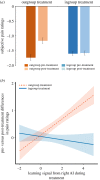Pain relief provided by an outgroup member enhances analgesia
- PMID: 30257910
- PMCID: PMC6170805
- DOI: 10.1098/rspb.2018.0501
Pain relief provided by an outgroup member enhances analgesia
Abstract
Pain feels different in different social contexts, yet the mechanisms behind social pain modulation remain poorly understood. To elucidate the impact of social context on pain processing, we investigated how group membership, one of the most important social context factors, shapes pain relief behaviourally and neurally in humans undergoing functional neuroimaging. Participants repeatedly received pain relief from a member of their own group (ingroup treatment) or a member of a disliked outgroup (outgroup treatment). We observed a decrease in pain ratings and anterior insula (AI) pain responses after outgroup treatment, but not after ingroup treatment. Moreover, path analyses revealed that the outgroup treatment induced a stronger relief learning in the AI, which in turn altered pain processing, in particular if the participant entered the treatment with a negative impression toward the outgroup individual. The finding of enhanced analgesia after outgroup treatment is relevant for intergroup clinical settings. More generally, we found that group membership affects pain responses through neural learning and we thus elucidate one possible mechanism through which social context impacts pain processing.
Keywords: anterior insula; classical conditioning; expectation; ingroup bias; outgroup support; reinforcement.
© 2018 The Author(s).
Conflict of interest statement
We declare we have no competing interests.
Figures




Similar articles
-
Learning from Ingroup Experiences Changes Intergroup Impressions.J Neurosci. 2022 Sep 7;42(36):6931-6945. doi: 10.1523/JNEUROSCI.0027-22.2022. J Neurosci. 2022. PMID: 35906067 Free PMC article.
-
Why We Learn Less from Observing Outgroups.J Neurosci. 2021 Jan 6;41(1):144-152. doi: 10.1523/JNEUROSCI.0926-20.2020. Epub 2020 Nov 17. J Neurosci. 2021. PMID: 33203741 Free PMC article.
-
Increased Moral Sensitivity for Outgroup Perpetrators Harming Ingroup Members.Cereb Cortex. 2016 Jan;26(1):225-33. doi: 10.1093/cercor/bhu195. Epub 2014 Sep 2. Cereb Cortex. 2016. PMID: 25183886
-
Insights From fMRI Studies Into Ingroup Bias.Front Psychol. 2018 Oct 1;9:1868. doi: 10.3389/fpsyg.2018.01868. eCollection 2018. Front Psychol. 2018. PMID: 30327636 Free PMC article. Review.
-
Attentional saliency and ingroup biases: From society to the brain.Soc Neurosci. 2020 Jun;15(3):324-333. doi: 10.1080/17470919.2020.1716070. Epub 2020 Jan 17. Soc Neurosci. 2020. PMID: 31928322 Review.
Cited by
-
The skin conductance response indicating pain relief is independent of self or social influence on pain.Psychophysiology. 2022 Mar;59(3):e13978. doi: 10.1111/psyp.13978. Epub 2021 Dec 2. Psychophysiology. 2022. PMID: 34859462 Free PMC article.
-
The mere physical presence of another person reduces human autonomic responses to aversive sounds.Proc Biol Sci. 2020 Jan 29;287(1919):20192241. doi: 10.1098/rspb.2019.2241. Epub 2020 Jan 22. Proc Biol Sci. 2020. PMID: 31964306 Free PMC article.
-
The effects of psychosocial stress on intergroup resource allocation.Sci Rep. 2019 Dec 9;9(1):18620. doi: 10.1038/s41598-019-54954-w. Sci Rep. 2019. PMID: 31819104 Free PMC article.
-
The influence of social signals on the self-experience of pain: A neuroimaging review.Front Neurol. 2022 Aug 26;13:856874. doi: 10.3389/fneur.2022.856874. eCollection 2022. Front Neurol. 2022. PMID: 36090868 Free PMC article. Review.
-
The Effect of Everyday-Life Social Contact on Pain.J Med Internet Res. 2024 Apr 30;26:e53830. doi: 10.2196/53830. J Med Internet Res. 2024. PMID: 38687594 Free PMC article. Review.
References
Publication types
MeSH terms
Associated data
LinkOut - more resources
Full Text Sources
Other Literature Sources
Medical

